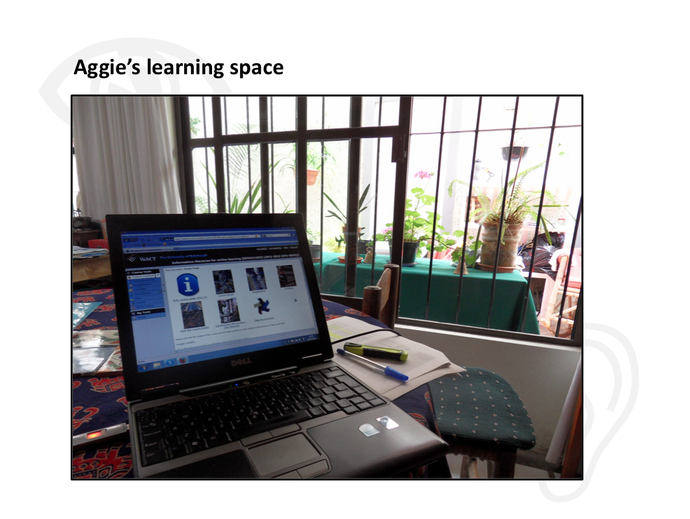|
In the last couple of weeks Michael Sean Gallagher and I have been adding the final touches to a book chapter which explores The Sonic Spaces of Online Distance Students. Working with our mentor Professor Siân Bayne from the University of Edinburgh, we have proposed a methodology which uses aural and visual data as a way of understanding how online distance students construct space for studying. The chapter will feature in a wider text concerned with place-based learning that will be published later this year, however this is a subject that Michael and I have been researching and thinking about since 2010. Our chapter revisits data that Michael and I collected as part of the New Geographies of Learning project that we worked on together in 2011. Along with our colleagues from the MSc in Digital Education at Edinburgh University, we prepared two published papers from this work (references below). We also generated a series of 'digital postcards', where we invited online distance students to 'capture' a space from where they typically engaged with their programme of study. The postcards were digital in the sense that they each combined a photograph, short text description and an audio field recording of the same space. It was this audio and visual data that Michael, Siân and I returned to look at in more detail within our book chapter. Although the ink is still drying on the print and photographs that make up our chapter, earlier this week Dr Louise Connelly from the Institute of Education at The University of Edinburgh gave us the opportunity to talk about our work as part of her online tutoring course for staff. You can look at my slides from the session, however what you'll learn from a series of images that depict soft furnishings, I'm not sure. The central thrust of our webinar was a discussion of the methodology we devised. Key to our thinking was to avoid the tendency amongst Internet scholars to privilege image over sound (Sterne 2006), and to instead think about the interdependency, cohesion and conflict between different semiotic material. In the absence of an existing approach to transcription or analysis that suited our needs, we developed our own approach by drawing on a range of methodologies concerned with aural and visual data, and the relationship between different semiotic modes. In brief summary we:
To demonstrate our methodology during Monday's webinar, we invited participants to look at examples of data gathered within the New Georgraphies of Learning project. This included thinking about the digital postcard submitted by Aggie, an online distance student based in Mexico, but completing a programme at Edinburgh University. We invited participants in the webinar to reflect on whether there was anything interesting, surprising or seemingly significant about the study space captured in this postcard image: Using the Chat function in Collaborate we then asked the group to share their ideas about the study space in the photograph. There were more thought-provoking observations than I have room to include here, however it was interesting to note that a number of themes that Michael and I found to be present in the wider data set (i.e. across many of the 15 submitted postcards) arose during the webinar discussion. This included:
In the second part of the exercise, we invited the group to look at the image once again, but this time whilst listening to the audio clip that Aggie submitted to accompany her image: As we listened to the orchestration of birdsong, distant brass music, children-at-play and the chopping-of-vegetables that feature in Aggie's field recording, fascinating strands of conversation developed within the Chat box. This included differing positions on what represents 'noise', and whether music can be used to usefully construct spaces that are conducive to studying. Both of these themes are discussed within our forthcoming chapter. What was also interesting was the way that conversation moved onto discuss whether the insights gained from our methodology might practically inform course design and teaching of online distance courses. I have reproduced some of the comments below in order to give a feel for the nature of the discussion.
Within our chapter, Michael, Siân and I have been clear to avoid suggesting that the themes to emerge from our transcription and analysis of the digital postcards necessarily sets hard-and-fast rules about the ways that online students use sound and physical material to construct spaces for studying. What we did propose though was that this type of data - and our methodology - offers new ways of thinking about the nature of these spaces. I think that the conversation reproduced above helps to support this.
If we were to deliver this session again - and I really hope we get the chance to do so as it was great fun and opened up new lines of investigation - I would leave more time for participants to reflect on whether and how the introduction of the aural data altered original impressions of the study space captured in the image. It's clear that listening to Aggie's sound clip enabled the group to see beyond the edges of the photograph, however I think we missed an opportunity to really discuss how the interplay between the aural and the visual data potentially generated meaning over and above the impressions we might have taken from these individual modes. As I mentioned in my introduction, Michael and I have been discussing the nature of online study spaces for close to 5 years: I think this week's webinar suggests there's value in continuing the conversation. References
0 Comments
Leave a Reply. |
Search categories
All
I am a Lecturer in Digital Education (Education Futures), within the Centre for Research in Digital Education at The University of Edinburgh.
@james858499 [email protected] |


